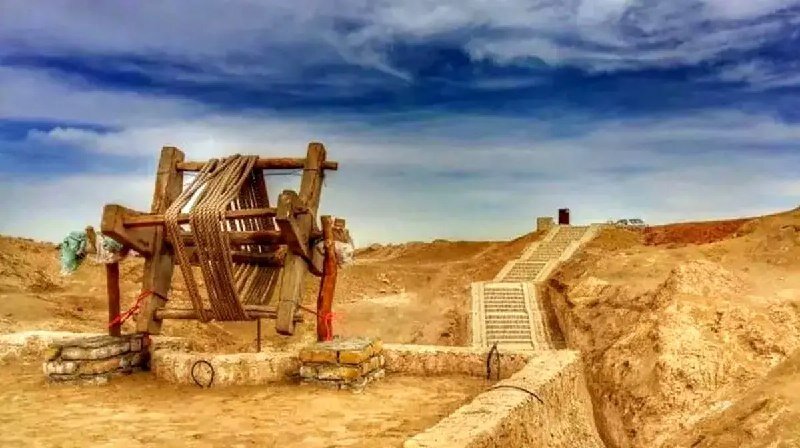Tehran – Experts at Kanat (ancient groundwater network) who conducted extensive research on the remaining Qanats of Iran, writes Irna, believe that the great emperors of Iran during the Achemenid and Sassanid eras benefited from Iran’s fisheries and hydrological knowledge.
Mohammad Balshan said, “If someone irrigated dry land through the construction of Kanat during the Akemenid era, he/she was exempt from paying taxes for five years.”
The role of water in life and the way it appealed was extremely important to Iranians in the past.
The formation of kanath using an accurate and engineered model is based on attitudes towards the role of water in Iranian livelihoods.
Iran has the longest, oldest canut in the world.
UNESCO has listed 11 Iranian kanaths on the World Heritage List as engineering masterpieces in water resource management.
UNESCO says “Kanut offers exceptional testimony to the cultural traditions and civilizations of desert regions with arid climates.”
Generally, each Qanat consists of an almost horizontal tunnel for collecting water from an underground water source, usually an alluvial fan.
Barshan, manager of the Kerman Qanat Center, said the stone inscriptions and tablets remaining from ancient Iran show that people at the time brought groundwater to villages and cities by digging long and very deep aqueducts.
Professor Henry Gubler, who has been studying Iranian aqueducts for over 30 years, estimates that these aqueducts are more than 400,000 kilometers long.
According to Barshan, the Gonabad Qanat is 35km long and over 300m deep, with wells at regular intervals of 50m. This is one of the masterpieces left behind in the Achemenid era.
On a trip to Gonabad, Nasser Khosrow Qobadiani calls Gonabad Qanat a water-rich, profitable aqueduct.
Barshan believes the greatness of Iranian aqueducts is that international groundwater experts, such as Batello and Abelman, believe that the aqueducts in Los Angeles and Pasadena, California, and the aqueducts in Chile and Mexico were built by Iranian engineers and workers.
Most of the ancient civilizations form on the banks of rivers such as the Nile, Tigris, Euphrates, Lakes and Yangtze Rivers, but Iran was the only country that formed far from the main rivers and became a world empire.
He pointed to advances in Iran’s hydrological knowledge during the Islamic era.
The book by Athar Al-Baqiyyah by Abu Rayhan Al-Biruni focuses on increasing and decreasing water in springs and rivers. The increase in water is not the same throughout the year, but there are significant differences.
For example, Jihoon’s water increases as tigris and euphrates decrease. Therefore, since sources in cold-hardy areas have more water in the summer and less water in the winter, mountain humidity causes an increase and decrease in water in these rivers, there are fewer sources in the winter.
He said that Avisenna, the great Persian physician and most famous and influential philosopher and scientist of the medieval Islamic world, assigned a chapter in his book, The Alaee Encyclopedia, to knowledge of water.
Built near Tabas during the Achemenid period, the Culitz Dam was once renovated during the Sassanid period, while others were renovated during the Nasiredyn Toshi period in Kaje (A.S. 1201-1274).
The 64m tall dam has been the largest dam in the world for over 600 years.
Over 60 dams were built during the Achemenid era in Iran. Additionally, during the Sassanid era, a bridge was built in Shushtar, which was over 500 meters long. Bridges can also be seen throughout Iran, including Salvesten and Miane. All of these are signs of knowledge of ancient Iranian hydrological science.
Elsewhere in his remarks, he pointed to an Iranian waterwheel, which was considered another part of the Iranian hydrological cycle. The Iranians had factories in ancient Iran that included wheel mills and floating factories.
The ruins of these factories can still be seen in Schushtar. Chogha Zanbil’s water purification equipment is also the first and oldest water purification equipment in the world, transforming the muddy waters of the Cullet River into healthy, refreshing water through associated containers. Water reservoirs in the desert region were another example of ancient Iran’s advanced fisheries industry.
The center specialised in storing and purifying water was converted and cooled simultaneously. Traces of Susa and Shushtar water coolers were also found along with explanations from tourists and sailors such as Naser Khosrow.
Also, sea lighthouses and climatic conditions are other parts of Iranian hydrological science.
KD

